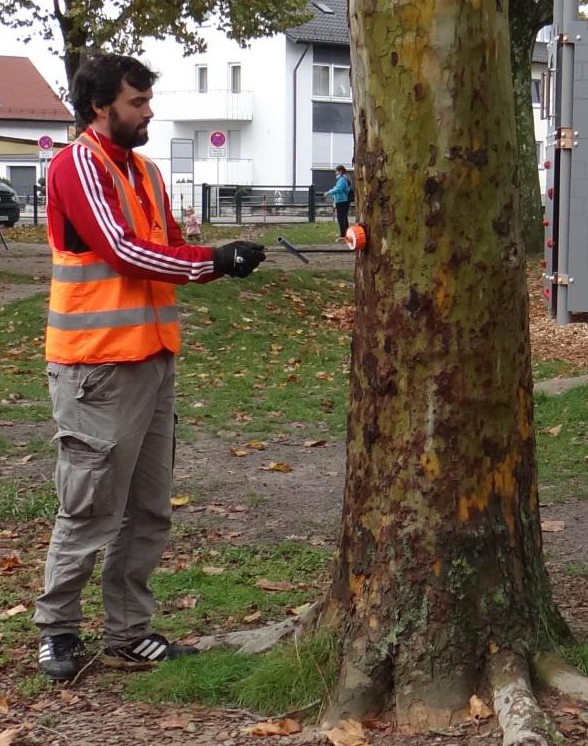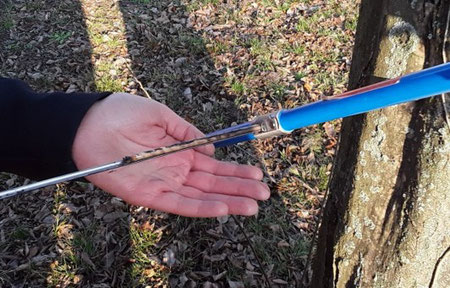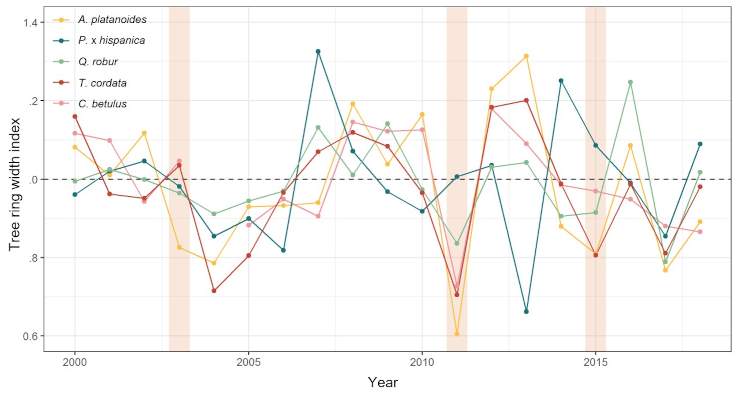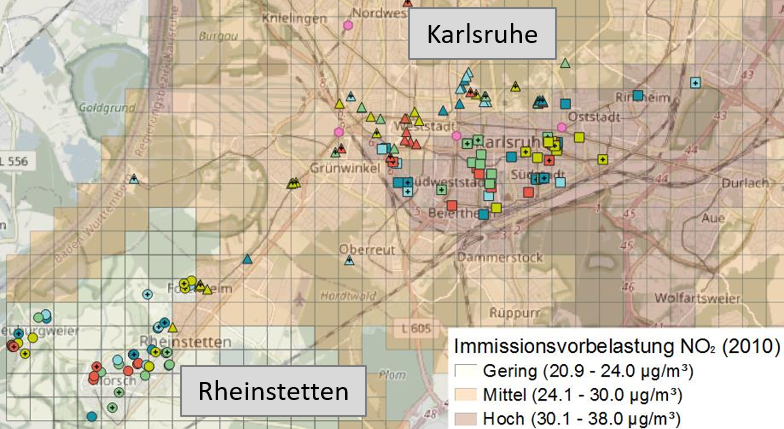In Germany, about one third of the population lives in cities. Because of increasing sealing, urban heat islands and high emission loads, cities are particularly affected by heat stresscaused byclimate change. Therefore, adaptation measures are needed to sustainably improve the inner-city microclimate, air quality and living conditions of the urban population. Urban green spaces and, in particular, urban trees make an important contribution to counteracting the effects of climate change. They reduce urban heat in summer, provide shade and keep our air clean.
In order to be able to maintain theservices of urban trees in the future, some crucial questions arise: which tree species react particularly sensitively to the consequences of air pollution and climate change, such as heat and drought? Which tree species are particularly resilient and thus suitable for mitigating the effects of climate change in cities in the future? A look inside urban trees helps to clarify these questions. Dendrochronological and isotope-based approaches were carried out in this subproject by taking drill corest. This allowed conclusions to be drawn about the suitability of different tree species in urban environments. Dendrochronology, i.e. tree-ring research, was used to determine the resistance, recovery ability and resilience of selected tree species from Karlsruhe. As a resulthe tree species' tolerance to drought, among other things could be measured. The influence of heat stress and drought on tree physiology was also determined by isotope analysis. In addition, isotope analysis provided evidence of air pollution in Karlsruhe.
Was und die Jahresringe städtischer Bäume verraten
Für die Untersuchungen wurden zunächst Bohrkerne mithilfe eines speziellen Bohrers manuell entnommen. Die Bohrkerne sind etwa bleistiftdick und liefern einen Querschnitt des Baumes bis zum Baummittelpunkt. Dadurch kann man die Jahresringe sehen, der Baum selbst kann jedoch weiterleben. Neben dem Alter des Baumes (Jahresringanzahl), gibt die Breite der Ringe Aufschluss über das jährliche Baumwachstum. Je breiter der Ring, desto günstiger waren die Umweltbedingungen und umgekehrt. Extreme Wetterereignisse, wie Trockenheit und Hitze sowie Umweltbelastungen, wie Abgase oder Feinstaub, können Störungen im Wachstum hervorrufen und mithilfe von Wetter- und Klimaaufzeichnungen zusätzlich analysiert werden. So kann zum Beispiel herausgefunden werden, wie gut sich ein individueller Baum von einem Trockenjahr (2003, 2008, 2011, 2015) erholt hat, also wie widerstandsfähig er ist und wie sich diese Fähigkeit bei verschiedenen Baumarten unterscheidet. Jahr für Jahr archiviert ein Baum zudem eine Art isotopischen Fingerabdruck in den Jahresringen. Darin ist beispielsweise das Verhältnis von stabilen Isotopen abgespeichert. Das Isotopenverhältnis ist abhängig von Umweltbedingungen, sodass Rückschlüsse auf damalige Umwelteinflüsse möglich sind.
The five tree species investigated
Within the scope of the subproject, about 150 trees of the most common tree species in Karlsruhe and Rheinstetten - Norway maple, small-leaved linden, English oak, hornbeam and Plane tree - were examined. The drought response of the five tree species was investigated for the years 2003, 2011, and 2015, during which pronounced dry periods occurred during the growing season. A tree ring chronology was created for each of the sample trees, mapping the variation in stem thickness growth based on the measured tree ring widths. To determine how stem thickness growth responded to drought, the indices resistance and resilience were calculated. Resistance indicates how much the growth slump is compared to the previous year. Resilience is a measure of the extent to which a tree is able to return to previous growth levels after a dry period. In addition to tree ring width, isotopic signatures of carbon and oxygen in wood were analyzed, which can be used as indicators of a tree's water availability and physiological drought stress. Both tree ring width and carbon and oxygen isotopes were examined for their relationship with weathering.
The studies of the tree interior revealed that water availability in the spring, in particular, has a decisive influence on stem thickness growth and the response of urban trees to drought. Higher precipitation has been shown to be associated with higher stem thickness growth. In particular, precipitation in May - for Norway maple, hornbeam, English oak, and small-leaved linden - proved to be the most important influencing factor. The dependence of stem thickness growth on sufficient water availability in spring, is also reflected in the low resistance of all tree species (except sycamore) in the drought year 2011 compared to the drought year 2003, because in 2011 the most severe drought occurred in spring and in 2003 only later in summer. The drought years (2003, 2011 and 2015) are marked in light red in the figure.
Proven in drought conditions: Maple-leaved plane tree and English oak
Based on our results, sycamore and pedunculate oak in particular prove to be suitable for urban areas with regularly occurring dry periods. This became particularly clear in 2011, when spring precipitation was very low. Except for maple-leaved sycamore, no tree species showed sufficient resistance to drought and heat. In 2015, English oak and maple-leaved sycamore proved to be the most resistant tree species to persistent drought.
In addition, analysis of carbon and oxygen isotopic signatures showed physiological adaptation to drought in Norway maple and sycamore in 2003 and 2015, and in 2011 Norway maple and littleleaf linden were found to have increased water use efficiency as an adaptation to drought. Sycamore and English oak did not show increased values in the same year, so comparatively low drought stress can be assumed here.
Site characteristics, on the other hand, showed only a minor effect on the resistance and resilience of the tree species studied. Thus, an influence of the distance to roads as well as the level of traffic emissions could not be confirmed. A slight influence of soil properties was only found with respect to soil type and organic carbon content. Fast growing trees also showed a lower recovery of growth after drought than slow growing trees.
Nitrogen isotope analysis proved to be a useful method to determine the exposure of trees to traffic emissions. In our studies, tree species was shown to be the most important factor in explaining the variability of the isotopic composition of nitrogen. The distance to the nearest road and the intensity of traffic emissions also had a significant influence. The estimated values for the ratio of stable nitrogen isotopes were higher the closer the tree was to a road and the higher the nitrogen oxide emissions at that location. This result confirms that exposure to traffic emissions is reflected in the isotopic composition of nitrogen in the wood of urban trees.
Now what?
The investigations clearly show that the five tree species studied, which together make up more than one third of the tree population in the study area, differ in terms of stem thickness growth, in some cases strongly, in their tolerance to drought. Based on our surveys, maple-leaved sycamore and pedunculate oak prove to be particularly suitable for urban areas with regularly occurring dry periods. With the exception of sycamore, it is clear across all tree species that spring water availability, in particular, plays a critical role in stem thickness growth and drought response. These findings are important for translating the results into specific irrigation strategies. Thus, for sycamore and English oak, where resistance and resilience are generally higher, irrigation does not seem to be absolutely necessary, or for English oak only in case of drought in spring, to which it reacts particularly sensitively. This is also true for the tree species European linden, hornbeam and Norway maple, so that irrigation would probably have a positive effect on stem thickness growth in the absence of precipitation in spring/early summer. Based on these results, a tool will be developed in the follow-up project GrüneLunge 2.0 to help municipalities select appropriate tree species. More information on our planned activities in the GrüneLunge 2.0 project can be found here: Urban tree suitability in climate change.
.png)



